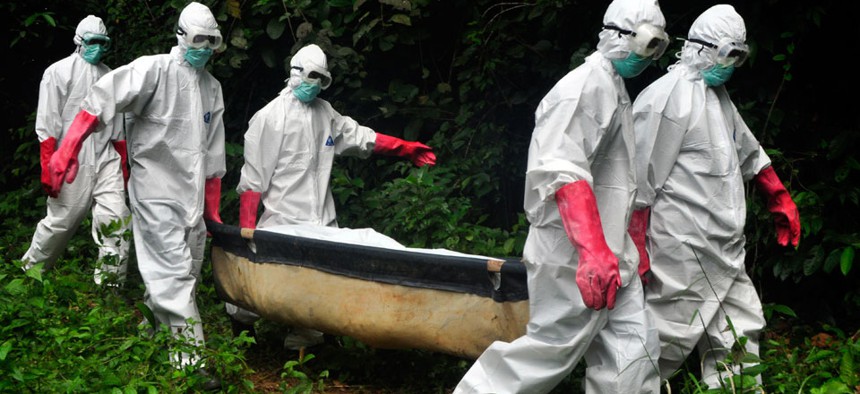Big Data Might Have Stopped Ebola in Its Tracks

A burial team in protective gear carry the body of woman suspected to have died from the Ebola virus in Monrovia, Liberia. Abbas Dulleh/AP File Photo
Computational epidemiologists were among the those who foresaw the crisis to come.
The largest-ever outbreak of Ebola began in Guinea in late 2013, hundreds of miles away from rural communities in Central Africa where the virus is usually found. When Ebola took root in major cities on a different part of the continent, few recognized the threat. Ten months later, what started as an isolated problem has grown into an unprecedented public health emergency for the region.
Computational epidemiologists were among the those who foresaw the crisis to come. Even the earliest forecasts of epidemic were dire. Multiple models in early August showed explosive growth with the potential for a long emergency. But the models were not enough to spur the international community into action, due in part to a failure of collective imagination. It was hard to believe that the outbreak would grow so large. By October, it was obvious that the early models were correct but it was too late.
In the past, partnerships to bring those results to decision makers during an active outbreak were rare. Most computational epidemiologists work at universities where theoretical research is more common than research that can be used to inform decision making. Academics are also accustomed to sharing their results through peer-reviewed journal articles that take many months to be published and are difficult for non-experts to understand. In the last few years, that has begun to change.
The research group I belong to at Virginia Tech partners with the Department of Defense and others to use computer models to predict an outbreak’s trajectory. The models combine data on the growth of the outbreak with Census records, clinical data about the disease, and other contextual information to predict the number of new cases in the coming months. We also use them to learn how best to respond to outbreaks, like whether contact tracing will be enough to slow an epidemic’s growth.
Other researchers focus on detection instead of prediction. Healthmap, founded in 2006, crawls news articles, social media, and other online sources for indications of public health threats. Without that system, epidemiologists must rely on hospitals, clinicians, or schools to identify and report outbreaks. “We hope that by providing information on emerging disease outbreaks early, public health institutions can investigate these outbreaks and work to control them before they get out of hand,” Dr. Elaine Nsoesie, a research fellow at Healthmap, told Quartz. A timeline of the Ebola outbreak on the Healthmap website found evidence of an unusual febrile illness in Guinea in early March, before the World Health Organization announced the outbreak.
Traditional epidemiology uses data from field investigations, surveys, and hospital records. These methods are time consuming and require money, manpower, and boots on the ground. In the midst of an outbreak, that speed can mean the difference between a local outbreak that is easily contained, and a regional public health emergency. With public health events time is of the essence. Each newly infected person must be identified before they can pass it to others. They must then receive treatment and isolation, and their contacts must be intensively followed. As the number of sick people grows, the public health response needed to control the outbreak explodes.
In the midst of an outbreak, public responders need insight as soon as possible. Information on the how fast the outbreak is growing, where it is spreading, and what is needed to stop transmission help responders to plan interventions where they are most likely to help. Computational epidemiologists specialize in providing that information quickly.
The biggest challenge we face is getting the quality data needed to build reliable models in a timely manner. The more information that can be included in the models about the epidemic to date, the better the predictions are about what is coming next, which in turn makes the results more useful to decision makers. The tighter the loop between data collection, model building, and public health response, the better.
The Ebola outbreak in West Africa has shown how computational epidemiology can detect and forecast epidemics without waiting for studies to be conducted on the ground. But in order to be of use, those results need to be delivered into the hands of people who trust them and can use them. Strengthening partnerships between those researchers and decision makers is the next step in pandemic preparedness and response.
NEXT STORY: 'Computer Chaos' at 20: Back where we started


